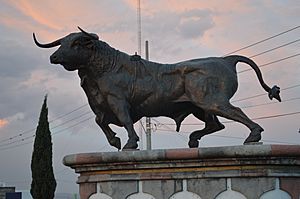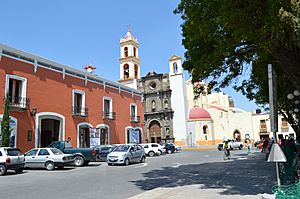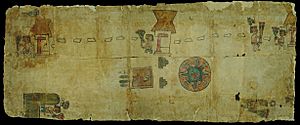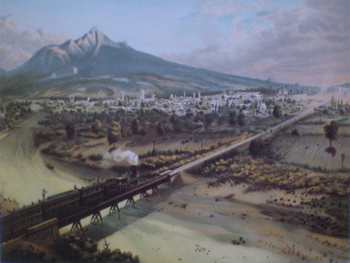Huamantla facts for kids
Quick facts for kids
Huamantla
|
|
|---|---|
|
municipal seat
|
|

Monument to the Bull
|
|
| Country | |
| State | |
| Time zone | UTC-6 (Central Time) |
| Website | Municipal website |
Huamantla is a small city in the eastern part of the Mexican state of Tlaxcala. It has a long history with indigenous people. The city itself was started in the 1530s during the early colonial period. Huamantla is mostly known for its yearly celebration for an image of the Virgin Mary called Our Lady of Charity. This celebration includes a month of fun events. The most famous events are the "night no one sleeps," when people make huge "carpets" on the streets from colored sawdust and flowers. Another famous event is the "Huamantlada," a running of the bulls, much like the one in Pamplona, Spain.
Contents
What Does Huamantla Mean?
The name Huamantla comes from several Nahuatl words. These words are cuahuitl (tree), man (next or in line), and tla (abundance). Put together, they mean "place of aligned trees."
Exploring Huamantla City
Huamantla city is in eastern Tlaxcala, about 45 kilometers (28 miles) from the state capital. When you enter the city, you'll see the Monument to the Bull. This bronze statue celebrates the area's tradition of raising bulls and bullfighting.
The city's center is Parque Juárez (Juarez Park). It has lovely gardens and a kiosk from the early 1900s. The buildings around the park are very old, some from the colonial period. They have simple fronts and balconies with iron railings. Because of these historic buildings and the August celebrations for Our Lady of Charity, Huamantla is called a "Pueblo Mágico" (Magical Town).
Historic Buildings
The main old buildings are the San Luis Obispo parish church and its former monastery. Both were started in the 1500s and are named after Huamantla's patron saint, Louis of Toulouse. The monastery was built between 1567 and 1585. It has a main church with a simple front. Inside, there is a special chapel for a Christ figure called the Señor del Desposo. The main altar is very fancy, in a style called Churrigueresque.
The San Luis Obispo Parish church is made of light stone with a dark gray main entrance. This entrance has six statues made of alabaster. Inside, the main altar is Baroque, with a statue of Louise of Toulouse. You can also see old oil paintings from the colonial period. One famous painting is of the Virgin of Guadalupe by Miguel Cabrera.
The municipal palace also faces the park. It's a two-story building with balconies, typical of Huamantla's style. Inside, you can see a mural by Desiderio Hernández Xochitiotzin. There's also a copy of the Huamantla Codex and a collection of old photos.
Puppet Museum
Modern Mexican puppetry started in Huamantla. The Rosete Aranda family began their traveling puppet show here in 1850. Today, Huamantla is home to the Rosete Aranda National Puppet Museum. It's the only museum of its kind in Latin America. The museum is in an old mansion facing the main square. It has eight rooms filled with puppets, sets, and other items from the Rosete Aranda family. You can also see puppets from other countries like Germany, Spain, and India. There's even a collection of ancient dolls or puppets with moving parts from nearby Cacaxtla.
Next to the puppet museum is the Huamantla Cultural Center. It's in a building from the 1700s or 1800s. This center has eight rooms for different art exhibits and workshops.
Bullfighting Museum
The Museo Taurino (Bullfighting Museum) is in an 18th-century building, right next to the city's bullring. It opened in 1981. The museum displays old posters from bullfighting events from the 1900s. You can also see models of different bullrings in Mexico, matador outfits, and photographs.
Huamantla Fair: A Big Celebration
The main event in Huamantla is the Feria de Huamantla (Huamantla Fair). It runs from July 31 to August 21. This fair likely started from ancient worship of the goddess Xochiquetzal, who was the goddess of love, flowers, and arts. After the Spanish arrived, they encouraged people to honor the Virgin Mary instead. In the 1600s, the Franciscans built a small church for Our Lady of the Assumption. The statue of the Virgin Mary there is now linked to many miracles. Thousands of people from Mexico and other countries visit the fair.
The statue is also known as Our Lady of Charity (Virgen de la Caridad). The fair has two main events:
- Sawdust Carpets: People create amazing "carpets" using colored sawdust, flowers, and other materials. These are made constantly from July 31 to August 15. On the night of August 14, called "the night no one sleeps," about 6 kilometers (3.7 miles) of these carpets are made on the streets. This is for the main procession with the statue on August 15. Before the procession, the statue gets new robes. People follow the statue with candles and fireworks.
- The Huamantlada: This is a running of the bulls held on August 19. It first happened in 1954 and has become very popular. It's similar to the running of the bulls in Pamplona, Spain. The first run had seven bulls, but now there are about twenty-five. The bulls are let loose into the streets from two directions. This event is the most famous of its kind in Mexico.
During the fair month, there are also other fun activities. These include donkey and car races, a children's version of the running with the bulls, a parade with floats, and a fair queen. There's also a paella festival, cockfights, a chess tournament, and an international puppet festival.
Culture and Food
During the fair and other traditional festivals, you can see traditional dances. These include Ketzalines, Vaqueros, Vasarios, and Matlachines. People dance to music played by bands with wind instruments. You can also see traditional clothing, which comes from the Otomi people. Men wear white pants and shirts with embroidery. Women wear colorful, heavily embroidered skirts, blouses, and a rebozo (shawl).
Typical foods include mixiotes (meat cooked in parchment), barbacoa (slow-cooked meat), mole with turkey, and Tocatlán-style chicken. For desserts, there are crystallized fruits and a sweet treat called muégano.
Huamantla Municipality
The city of Huamantla is the main government center for the communities around it. Together, they form a municipality that covers about 340 square kilometers (131 square miles). This area borders other municipalities like Terrenate and Ixtenco. The local government has a president, a syndic (legal representative), and seven representatives called regidors.
Outside the city, there are three main communities: Benito Juárez, Ignacio Zaragoza, and San José Xicohténcatl. These are rural areas where people mostly work in farming and raising animals.
The municipality also has many old haciendas (large estates). Most of them have been divided up, but some are still private properties. There are also twenty-one archaeological sites in the municipality. In the Santa Anita neighborhood of the city, you can find ancient columns on private land.
Geography of Huamantla
Huamantla municipality is in the eastern part of Tlaxcala, within the Central Mexican Highlands. It is about 2,500 meters (8,200 feet) above sea level. The land has three types of areas:
- About 20% is rugged mountains, found in the far north and south.
- About 30% is semi-flat, also in the north and south.
- More than half is flat, located in the center.
The far south of the municipality is part of the Malinche Volcano.
Water Sources
The area has small streams, but most of them only flow during the rainy season. They create ravines like Tecoac and San Luca. Most of the water supply comes from underground, accessed through 62 wells.
Climate
The climate in Huamantla is semi-dry and temperate. Most of the rain falls from May to September. The warmest months are from March to May, and the coldest are December and January. The average low temperature is 5.4°C (41.7°F), and the average high is 23.2°C (73.8°F).
Plants and Animals of Huamantla
About 35% of the municipality has wild plants, mostly near La Malinche. The types of plants change with how high up you go. At lower elevations, you'll find holm oak trees, some pines, and bushes. Above 2,800 meters (9,200 feet), you can find oyamel fir trees (Abies religiosa) and Pinus hartwegii pines. Even higher, above 4,300 meters (14,100 feet), there are alpine grasslands and a type of juniper (Juniperus monticola). More than 60% of the trees are conifers (like pines), and the rest have broad leaves.
Even though most flat areas are used for farming, some wild plants remain. These include maguey (Agave horrida and Agave salmiana), sotol (Nolina longifolia), Yucca filifera, and different types of cacti. Wildlife is mostly found outside the city. You might see rabbits (Silvilagus floridanus), hares (Lepus californicus), various birds, and reptiles.
Huamantla's History
Ancient Times
The first settlement in the Huamantla area was south of the current city. It was one of thirteen villages that formed a group from 1800 to 1200 BCE. At its peak, it had about 3,500 people. Later, a new powerful center appeared at a place called Los Cerritos de Natividad, east of Huamantla. This era saw the building of pyramids and planned cities.
After that came the Texoloc era, from 800 to 600 BCE. During this time, architecture included pyramids with special designs, and pottery showed influences from other parts of Mexico. The Tezoquipan era, from 350 BCE to 100 CE, was a time of great cultural and technological growth. They had advanced water systems, impressive buildings, and strong trade connections. Huamantla itself was home to three settlements with pyramids and planned layouts around plazas.
The area then declined from 100 to 650 CE, mainly because of the rise of big cities like Teotihuacan and Cholula. People moved away from Tlaxcala, and the area became a part of these larger empires. Teotihuacan used Huamantla as a trade route, but no major cities were built there.
Later, between 650 and 900 CE, the Otomi people began moving into the Huamantla Valley. There's also evidence of influence from other groups. After Teotihuacan fell, local groups gained control of the trade routes. The Otomi people became a major cultural force. Much of this history is known from the Huamantla Codex. This is a very important document, one of the few that tells the story of an Otomi group. It's in nine pieces, with seven in Mexico City and two in Germany. The codex mainly tells about a battle between new Otomi arrivals and those already living there. The newcomers won, allowing them to settle near the Malinche Volcano. These Otomi were still powerful when the Spanish arrived.
The last major indigenous power in Huamantla was the Tlaxcallan dominion, which is where the state of Tlaxcala gets its name. This group formed around 1100 CE. Huamantla belonged to the Tecoac dominion, one of the four parts of the Tlaxcallan kingdom. This area was the first to meet Hernán Cortés and his army in 1519. The Spanish used their advanced weapons to quickly defeat the native soldiers.
Colonial Period
Because Tlaxcala helped the Spanish in the Conquest of Mexico, its indigenous leaders kept some special rights. In 1528, a group of indigenous leaders went to Spain. They asked for permission to start the settlement of Huamantla. Permission was given in 1535. The Franciscans began building the San Luis Obispo monastery in 1567, finishing it in 1585. This monastery became the main religious center for the area. Schools and eleven other churches were also built around the city.
Huamantla quickly became an important farming center for eastern Tlaxcala. By the end of the 1500s, the valley changed from forest to farmland, growing corn, wheat, and raising sheep. Spanish people started buying land from indigenous leaders. However, the indigenous council in Tlaxcala city controlled most of the workers. This led to conflicts, but indigenous leaders in Huamantla still had more power than in other parts of New Spain.
In 1785, Tlaxcala became part of the province of Puebla, but this was changed back in 1793. At this time, Tlaxcala was divided into seven areas, and Huamantla was one of them.
From Independence to Today
In 1810, most indigenous people in Tlaxcala supported Miguel Hidalgo y Costilla's fight for independence. There were small rebellions in Huamantla. In 1821, near the end of the war, Tlaxcala openly supported Mexico's independence.
Huamantla became a municipality in 1822. In 1847, the city was given the title "heroic" because of its role in fighting against the US invasion during the Mexican American War.
During the Reform War, Huamantla briefly became the capital of Tlaxcala in 1858. The French army took the city in 1863. After the French left, the capital moved back to Tlaxcala city. In the late 1800s, Huamantla grew with the building of a railroad. This helped haciendas sell their goods to other states and Mexico City.
During the Mexican Revolution, there was unhappiness with the government. Hacienda workers were paid very little. Early rebellions were put down, but eventually, revolutionary troops took control of the city in 1913.
After the Revolution, Huamantla grew again. It added more businesses and industries. In the 1940s, the first modern factories were built, making things like powdered milk, cookies, and fertilizers. Later, clothing and textile factories were also built.
Telephone service came to Huamantla in 1932. Newspapers and a radio station (XEHT) were also started. The first flights to the city happened in 1953.
The city has continued to grow. In 2007, the Mexican government named Huamantla a "Pueblo Mágico" (Magical Town). This was partly because of its famous celebrations for the Virgin of Charity and the Huamantlada in August. To get this title, the city also improved its downtown area, especially Parque Juárez.
Huamantla's Economy
Huamantla's economy still relies a lot on farming. About one-third of its workers are involved in growing crops and raising animals. Another third work in mining and industry, including making handicrafts. The last third work in commerce and services. Over half of the municipality's land is used for farming and grazing. Crops include corn, beans, wheat, peaches, and rye. Livestock includes cattle (mostly for dairy), pigs, sheep, goats, and chickens.
There are thirteen main industrial sites, mostly producing food products. Other factories make metal products, medicines, plastics, and leather goods. Traditional crafts include amate paper, made by the Otomi people. They also make pottery, textiles, masks, and dolls from dried corn husks.
Commerce and services are the fastest-growing parts of the economy. Huamantla is the start of a tourist route called "Huamantla and the East."
The municipality has 153.1 kilometers (95 miles) of roads, mostly secondary and rural roads.
Education in Huamantla
Huamantla municipality has 163 schools, from preschool to college. Most are public schools, with 29 being private. College-level schools include the Universidad Tecnológica del Tlaxcala and the Instituto Franciscano de Oriente. There is also a campus of the Universidad Popular Autónoma del Estado de Puebla, which offers high school and college education.
About 8% of the people in the municipality cannot read or write. This is a bit higher than the state average.
Sister City
See also
 In Spanish: Huamantla para niños
In Spanish: Huamantla para niños








